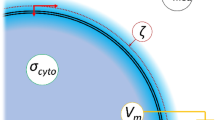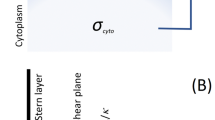Abstract
CYTOPLASMIC magnesium, whether free or complexed to nucleotides, has a fundamental physiological role as an essential cofactor for many cell enzymes, particularly those concerned with glycolysis, respiration and membrane transport. Various ingenious procedures have been applied to estimate1,2 or simulate3,4 intracellular conditions in relation to Mg but, because it is impossible to assess and control Mg2+ in the intact cell, most research on Mg requirements for metabolism and transport has used lysed cells5 and broken membrane preparations6,7, which have inherent uncertainties about true concentrations and sidedness of effects. Using a divalent cation ionophore8 and a newly developed method9,10 we have investigated Mg buffering in intact human red blood cells and have found that the fresh, oxygenated, inosine-fed cell (a condition frequently used for ion transport studies11–14) has three main buffer systems which bind nearly 90% of the total Mg present inside the cell in physiological conditions.
This is a preview of subscription content, access via your institution
Access options
Subscribe to this journal
Receive 51 print issues and online access
$199.00 per year
only $3.90 per issue
Buy this article
- Purchase on Springer Link
- Instant access to full article PDF
Prices may be subject to local taxes which are calculated during checkout
Similar content being viewed by others
References
De Weer, P. J. gen. Physiol. 68, 159–178 (1976).
Baker, P. F. & Crawford, A. C. J. Physiol., Lond. 227, 855–874 (1972).
Berger, H., Jänig, G., Gerber, G., Ruckpaul, K. & Rapoport, S. M. Eur. J. Biochem. 38, 553–562 (1973).
Gerber, G., Berger, H., Jänig, G. & Rapoport, S. M. Eur. J. Biochem. 38, 563–571 (1973).
Bodemann, H. H. & Hoffman, J. F. J. gen. Physiol. 67, 547–561 (1976).
Dunham, E. T. & Glynn, I. M. J. Physiol. Lond. 156, 274–293 (1961).
Schatzmann, H. J. & Vincenzi, F. F. J. Physiol. Lond. 201, 369–395 (1969).
Reed, P. W. & Lardy, H. A. J. Physiol. Chem. 247, 6970–6977 (1972).
Ferreira, H. G. & Lew, V. L. Nature 259, 47–49 (1976).
Lew, V. L. & Ferreira, H. G. Nature 263, 336–338 (1976).
Glynn, I. M., Lew, V. L. & Luthi, U. J. Physiol. Lond. 207, 371–391 (1970).
Lew, V. L. Biochim. biophys. Acta 233, 827–830 (1971).
Lew, V. L. in Comparative Biochemistry and Physiology of Transport (eds Bolis, L., Bloch, K., Luria, S. E. & Lynen, F.), 310–316 (North-Holland, Amsterdam, 1974).
Glynn, I. M. & Karlish, S. J. D. J. Physiol. Lond. 256, 465–496 (1976).
Funder, J. & Wieth, J. D. Acta Physiol. Scand. 68, 234–345 (1966).
Whittam, R. in Transport and Diffusion in Red Blood cells, 87 (Edward Arnold, London, 1964).
Deuticke, B., Duhm, J. & Dierkesmann, R. Pflügers Arch. 326, 15–34 (1971).
Author information
Authors and Affiliations
Rights and permissions
About this article
Cite this article
FLATMAN, P., LEW, V. Use of ionophore A23187 to measure and to control free and bound cytoplasmic Mg in intact red cells. Nature 267, 360–362 (1977). https://doi.org/10.1038/267360a0
Received:
Accepted:
Issue Date:
DOI: https://doi.org/10.1038/267360a0
This article is cited by
-
Colorimetric detection of magnesium (II) ions using tryptophan functionalized gold nanoparticles
Scientific Reports (2017)
-
Cold activation of Na influx through the Na-H exchange pathway in guinea pig red cells
The Journal of Membrane Biology (1993)
-
LTD4 increases cytosolic free calcium and inositol phosphates in human neutrophils: inhibition by the novel LTD4 receptor antagonist, SR2640, and possible relation to modulation of chemotaxis
Agents and Actions (1990)
-
Do viruses use calcium ions to shut off host cell functions?
Nature (1978)
-
Does ionophore A23187 mediate Na transport in the absence of divalent cations?
Nature (1977)
Comments
By submitting a comment you agree to abide by our Terms and Community Guidelines. If you find something abusive or that does not comply with our terms or guidelines please flag it as inappropriate.



